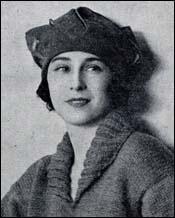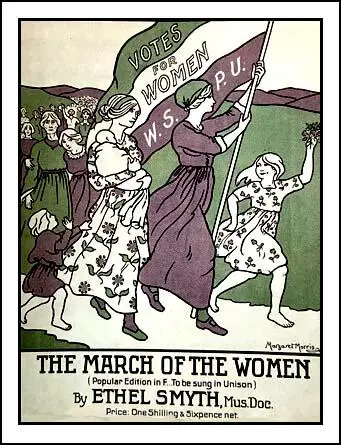Margaret Morris

Margaret Eleanor Morris, the daughter of an artist, William Bright Morris and his wife, Emily Victoria Maundrell, was born on 10th March 1891. Her parents took her to live in Boulogne when she was a few weeks old, so she grew up both bilingual and Francophile. In 1900 she joined the Ben Greet Shakespeare Company. Child parts in Drury Lane melodramas followed, and between tours she studied classical ballet In 1907 she joined Frank Benson's Shakespearian company as ingénue principal dancer. (1)
In 1909 she met Isadora Duncan's brother, Raymond Duncan, who was lecturing in London on the dance and music of ancient Greece. He emphasized the significance of the six Greek positions (copied from Greek vases) with their accentuated opposition of arms and legs which used every muscle in the body to achieve body control and balance. Margaret adopted his ideas to her individual style of dancing. (2)
In 1910 Margaret Morris composed Dance of the Furies, and trained a troupe of children to play the furies for Marie Brema's production of Gluck's Orpheus at the Savoy Theatre, for which she also designed the costumes and the decor. Her work met with great critical success, and her career as a choreographer was launched. (3)
Margaret Morris was beautiful woman who always attracted men's attention. In 1910 she had a brief but intense love affair with the writer John Galsworthy. With his financial support she founded a school of dancing in St Martin's Lane, London, to train children in her methods, and she formed her first touring company, Margaret Morris and her Dancing Children. (4)
Margaret Morris was a supporter of women's suffrage and had given donations to the Women's Freedom League and the Women Social & Political Union and was a member of the Actresses' Franchise League. She also took her youthful troupe, 'Margaret Morris's Dancing Children', to events in support of suffrage funds. (5)
In 1911 the composer Ethel Smyth wrote the music for March of the Women, with words by Cicely Hamilton. It was used by the WSPU during demonstrations. As Sylvia Pankhurst pointed out: "The swelling music of The March of the Women, strong and martial, bold with the joy of battle and endeavour, yet with a lasting undertone of sadness characteristic of that rebellious soul." (6)
Margaret Morris was commissioned to design the cover of the sheet music. Elizabeth Crawford has argued that her art-work shows the influence of Walter Crane. "Using the WSPU colours of purple, white and green Margaret Morris illustrates the women of the country, accompanied by their children, streaming over hill and dale in the wake of the 'Votes for Women' flag. They are gentile, loose-frocked in the Walter Crane style." (7)
In 1922 Margaret Morris started the first "educational" school in England to combine normal educational subjects with professional training in dancing and acting. "She adapted her techniques of breathing, posture, and movement so that they could be used to teach very young children, physically and mentally handicapped children, prenatal and post-natal women, and to aid post-operative recuperation. She became increasingly interested in the health-giving and remedial applications of her work. From 1925 she gave lecture-demonstrations to doctors and midwives and physiotherapists." (8)
In the years after the Second World War Margaret Morris founded both the Celtic Ballet and the Scottish National Ballet and in 1972 trained dancers for the production of "Hair". (9)
Margaret Morris died on 29th February 1980.
Primary Sources
(1) Elizabeth Crawford, Art and Suffrage: A Biographical Dictionary of Suffrage Artists (2018)
When Ethel Smyth's rousing "March of the Women", with words by Cicely Hamilton, was published at the beginning of 1911 it was Margaret Morris who was commissioned to design the cover of the sheet music. Signed, it is the only item of suffrage artwork known to be by her. In style it is reminiscent of Sylvia Pankhurst's design for the WSPU membership card, if less didactic. Using the WSPU colours of purple, white and green Margaret Morris illustrates the women of the country, accompanied by their children, streaming over hill and dale in the wake of the "Votes for Women" flag. They are gentile, loose-frocked in the Walter Crane style.
(2) Pam Hirsch, Margaret Morris: Oxford Dictionary of National Biography (6th January 2011)
Margaret Morris not only trained dancers for the theatre but, over her long career, she translated, modified, and refined her avant-garde ideas on dance into creative exercise systems for extremely diverse groups of people. She adapted her techniques of breathing, posture, and movement so that they could be used to teach very young children, physically and mentally handicapped children, prenatal and post-natal women, and to aid post-operative recuperation. In 1922 she started the first ‘educational school’ in England to combine normal educational subjects with professional training in dancing and acting. She became increasingly interested in the health-giving and remedial applications of her work. From 1925 she gave lecture-demonstrations to doctors and midwives and physiotherapists. In 1928 she published The Notation of Movement, which detailed the system she had been evolving and teaching since 1913, and which was publicized in the Margaret Morris Movement Magazine. In 1930 she passed the Chartered Society of Massage and Medical Gymnastics examination with distinction.
The teachers whom Morris had trained in her system of ‘Margaret Morris movement’ (MMM) started to be appointed residents at schools for disabled children. In 1935, in an attempt to influence the education authorities and to obtain wider recognition as a training college, she set up a non-profit making company in her London headquarters, in Cromwell Road. By 1937 MMM was officially endorsed as relevant to the 'health of the nation' when she was invited to become a founder member of the government's National Advisory Council for Physical Training and Recreation. The fifth marquess of Cholmondeley who, as chair of the Basic Physical Training Association, was concerned that the level of physical fitness in Britain was less than that of other nations, was impressed by Morris's creation of special exercises for each sport. He wrote an introduction to her book Basic Physical Training (1937). Male MMM teachers ran courses at Loughborough College, which had set up a department of physical education in 1931, offering a three-year course to men wishing to become games teachers. Arguably Morris's influence on mainstream education was at its height just before the outbreak of the Second World War.

